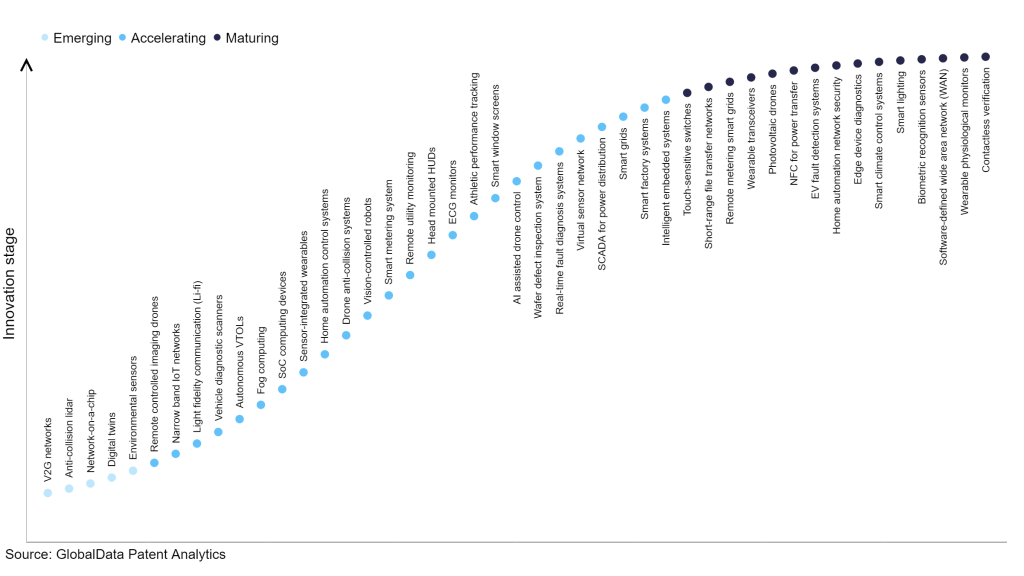The technology sector remains a hub of innovative activity, primarily fuelled by the convergence of technological progress, heightened connectivity, and the necessity for companies to enhance efficiency and competitiveness in a swiftly transforming marketplace, as well as growing importance of technologies such as light emitting diodes, photodetectors, signal processing algorithm, and light fidelity communication (Li-Fi) transceiver modules. These technologies collectively enable high-speed wireless communication using visible light in Li-Fi systems for applications where traditional radio frequency-based wireless communication may be limited or problematic. In the last three years alone, there have been over 3.6 million patents filed and granted in the technology industry, according to GlobalData’s report on Innovation in Internet of Things: Light fidelity communication (Li-fi). Buy the report here.

Access deeper industry intelligence
Experience unmatched clarity with a single platform that combines unique data, AI, and human expertise.
However, not all innovations are equal and nor do they follow a constant upward trend. Instead, their evolution takes the form of an S-shaped curve that reflects their typical lifecycle from early emergence to accelerating adoption, before finally stabilising and reaching maturity.
Identifying where a particular innovation is on this journey, especially those that are in the emerging and accelerating stages, is essential for understanding their current level of adoption and the likely future trajectory and impact they will have.
300+ innovations will shape the technology industry
According to GlobalData’s Technology Foresights, which plots the S-curve for the technology industry using innovation intensity models built on over 2.5 million patents, there are 300+ innovation areas that will shape the future of the industry.
Within the emerging innovation stage, environmental sensors, digital twins, and network-on-a-chip are disruptive technologies that are in the early stages of application and should be tracked closely. Intelligent embedded systems, smart factory systems and smart grids are some of the accelerating innovation areas, where adoption has been steadily increasing. Among maturing innovation areas are, contactless verification, wearable physiological monitors, and software-defined wide area network, which are now well established in the industry.
Innovation S-curve for IoT in the technology industry

Light fidelity communication (Li-Fi) is a key innovation area in IoT
Li-Fi is an advanced wireless communication technology that employs visible light communication (VLC) for transmitting data over high-speed internet connections. In contrast to Wi-Fi, which relies on radio frequencies, Li-Fi utilises visible light in the frequency range of 400 to 800 terahertz (THz). Like other wireless networks, Li-Fi operates by utilising LED lights to convey data using binary code. This technology enables ultra-fast broadband speeds, providing users with internet access without the need for extra hardware.
GlobalData’s analysis also uncovers the companies at the forefront of each innovation area and assesses the potential reach and impact of their patenting activity across different applications and geographies. According to GlobalData, there are 200+ companies, spanning technology vendors, established technology companies, and up-and-coming start-ups engaged in the development and application of light fidelity communication (Li-Fi).
Key players in light fidelity communication (Li-Fi) – a disruptive innovation in the technology industry
‘Application diversity’ measures the number of different applications identified for each relevant patent and broadly splits companies into either ‘niche’ or ‘diversified’ innovators.
‘Geographic reach’ refers to the number of different countries each relevant patent is registered in and reflects the breadth of geographic application intended, ranging from ‘global’ to ‘local’.
Panasonic is one of the leading patent filers in light fidelity communication (Li-fi). The company’s patents are aimed at an information communication method including continuously capturing an image of a subject that transmits a signal by changing luminance, with an image sensor, and displaying a captured image that includes a box.
The method also includes determining whether the subject is in the box and receiving the signal transmitted by the subject when it is determined that the subject is in the box. In the receiving, image data is obtained by capturing the subject with an exposure time, the signal is obtained by demodulating a bright line pattern, and the bright line pattern is caused to appear in the image data by setting the exposure time to be less than or equal to 1/480 second.
The other prominent patent filers in the space include Signify and Samsung.
By geographic reach, Texas Instruments leads the pack, followed by Procter & Gamble and Kawasaki Heavy Industries. In terms of application diversity, Walmart holds the top position, followed by Texas Instruments and International Mobile IoT.
The significance of Li-Fi lies in its potential to revolutionise wireless communication by providing high-speed, secure, and energy-efficient connectivity. With its unique characteristics and advantages, Li-Fi opens new possibilities for various applications, including smart homes, smart cities, industrial automation, healthcare, transportation, and beyond.
To further understand how IoT is disrupting the technology industry, access GlobalData’s latest thematic research report on Internet of Things – Thematic Research.
Data Insights
From

The gold standard of business intelligence.
Blending expert knowledge with cutting-edge technology, GlobalData’s unrivalled proprietary data will enable you to decode what’s happening in your market. You can make better informed decisions and gain a future-proof advantage over your competitors.







